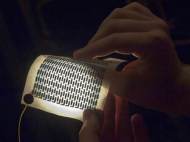MIT research led to simpler printing of photovoltaic cells on paper or fabric
 Almost as cheaply and easily as printing a photo on your inkjet, an inexpensive, simple solar cell can be created by special “inks” deposited on the paper. The researchers from MIT came with a process essentially the same as the one used to make the silvery lining on packages you see in everyday groceries – a vapor-deposition process that can be carried out inexpensively on a vast commercial scale.
Almost as cheaply and easily as printing a photo on your inkjet, an inexpensive, simple solar cell can be created by special “inks” deposited on the paper. The researchers from MIT came with a process essentially the same as the one used to make the silvery lining on packages you see in everyday groceries – a vapor-deposition process that can be carried out inexpensively on a vast commercial scale.
Unlike other ways used to create similar solar cells, which require exposing the substrates to potentially damaging conditions, either in the form of liquids or high temperatures, the new printing process uses vapors, not liquids, and temperatures less than 120° Celsius (248° Fahrenheit). These conditions enable the use of ordinary untreated paper, cloth or plastic as the substrate on which the solar cells can be printed.
In order to counter paper’s rough, fibrous surface at a microscopic scale, past attempts have relied on coating the paper first with some smooth material. But in this research, ordinary, uncoated paper was used — including printer paper, tissue, tracing paper and even newsprint with the printing still on it. In order to create an array of photovoltaic cells on the paper, five layers of material need to be deposited onto the same sheet of paper in successive passes, using a mask (also made of paper) to form the patterns of cells on the surface. And the process has to take place in a vacuum chamber.
The resilient solar cells still function even when folded up into a paper airplane. The researchers have also printed a solar cell on a sheet of PET plastic (a thinner version of the material used for soda bottles) and then folded and unfolded it 1,000 times, with no significant loss of performance. By contrast, a commercially produced solar cell on the same material failed after a single folding. They also printed on top of a finished paper solar cell through a laser printer, subjecting it to the high temperature of the toner-fusing step, and demonstrated that it still worked. Test cells the group produced last year still work, demonstrating their long shelf life.
Being able to print solar cells directly onto inexpensive, easily available materials such as paper or cloth, and then easily fasten that paper to a wall for support, could ultimately make it possible to drastically reduce the costs of solar installations. For outdoor uses, the researchers already demonstrated that the paper could be coated with standard lamination materials, to protect it from the elements.
Unfortunately, the current paper-printed solar cells have an efficiency of about 1 percent, but the researchers from MIT believe this can be increased significantly with further fine-tuning of the materials.
For more information, read the article published in the journal Advanced Materials named: “Direct Monolithic Integration of Organic Photovoltaic Circuits on Unmodified Paper”.









Gosh, I wish I would have had that inrfomation earlier!